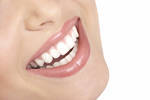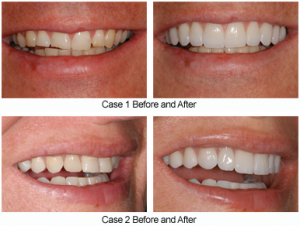When tooth mass is less than the size of the arch it is contained within the resultant effect is spacing. This can present in a minor fashion involving only a slight space between teeth or may present in a more major way exhibiting large space areas between two or more teeth. Most commonly we view this in the upper anterior teeth. The involvement between the central incisors is that area that usually signals an aesthetic concern. However, diastema presence between central/laterals, laterals/cuspids and even cuspid/bicuspids often coexists in the patient with diastemas between the central incisors. Attention to all areas of spacing is significant in attaining a natural and harmonious smile that will fit with the perioral and extraoral features of that patient.
Diastemas can be due to growth and development deficiencies, excessive incisor vertical overlap from different causes, tooth size discrepancies, tooth angulations, pathological conditions, as well as many other factors (Reference 1 ). Space closure can be attained through different modalities of treatment such as orthodontics and restorative/esthetic procedures. While orthodontic treatment is always an important choice to consider, it does not give the latitude to dramatically change shade, proportion and balance to a patients smile. The art of smile design as taught by such aesthetic programs as the Aesthetic Advantage (New York, Palm Beach, London, Indianapolis), takes into consideration the total patient concept of determining the right smile design for that patient. That concept being detailed evaluation of the intra oral, perioral, and extra oral features of that patient combined with a comprehensive evaluation of the functional concerns to make that smile design harmoniously coexist.
Diastema closure is one of the more common indications for the use of porcelain veneers. However, closure of a diastema without consideration of length and width proportions of all teeth in the smile envelope will most likely result in esthetic compromise. In other words, the space must be closed proportionally and distributed amongst all the anterior teeth/posterior teeth exposed during smile. If the size of the diastema is x, then the distal margin of the centrals should be trimmed to x/2. This should proportionally be done at the laterals within the limits of x/4 and should be compensated for with the canine width (Reference 2).
Rarely are we able to close these spaces without also affecting the vertical dimension of the teeth involved. This means lengthening the teeth in some fashion. We are limited to only three possibilities. Length gained from the gingival aspect or length gained from the incisal aspect or a combination of both. Obviously, if our need is to expose more incisal edge to our tooth for either functional or esthetic reasons or gingival display is not a concern, and then length need only be acquired from the incisal direction. If the incisal edge length is acceptable then length can be gained from the gingival direction. However, more often than not, a combination of these two directions is necessary to meet the esthetic demands of proportion to prevent the veneers from looking either too short or too wide. Consideration to the gingival zenith position is also important. Diastema closure often requires repositioning of the gingival zenith mesially. This avoids a mesially tilted appearance of the involved teeth (Reference 2__).
If we take a moment and begin to evaluate this patient from the inside the mouth then out and back we will see the importance of proportion and the interrelationship of tooth size to the surrounding introral and extraoral features of that patient. This holds true for what ever case scenario we are presented with. It can be the crowding case, the normal alignment case or germane to our discussion here, the excessive spacing case.
It is readily apparent that tooth mass is disproportionate to the surrounding features of this patients face. Tooth length and width are remiss and must be added to improve not only the dental esthetics but the overall facial esthetics of this patient.
The diastema between the central incisors poses our first concern. How do we close this space and create a harmonious emergence profile of the ceramic veneers and how do we maintain the proper length to width ratio while doing this? Soft tissue alteration is a critical element in setting up this scenario. Because of the diastema, normal and esthetic interdental papilla form is missing. Closure of this space by the ceramic veneer provides only a part of our esthetic goal. Creating the dental papilla is the other. To do this it is important to remember that vertical length of the interdental tissues should be maintained as much as possible. The likelihood of creating a dark triangle increases if the distance between the intercrestal bone and the apical contact of the veneers is more than 5 mms (Reference 3__ ). Additionally, the emergence of the restoration from beneath the gingival tissues (interdental papilla) must do so in such a way as to mimic the natural anatomical design of the tooth/ soft tissue relationship. If we attempt to design the preparation through traditional preparation design protocols by staying supragingival (if possible) and creating the interproximal elbow, our resultant prep (although in theory correct) would fall short of allowing us to achieve the esthetic goal. In other words, the ceramist would only be able to extend the porcelain from the prepared margins interproximally. Prepped in the above manner would result in no other choice but to have ceramic extended at angles to close the diastema and an interproximal thickness of the ceramic that would be thin lending to the possibility of shine through of the dark area of the mouth. Additionally this would yield an improper emergence profile and square disproportionate veneers.( Reference 4) . Creating proper preparation design for diastema closure requires that the finish margins on the diastema side be placed subgingivally (Reference 2). Cuffing of the interdental papilla ( Oddessey Diode Laser, Ivoclar) without altering the papilla height in addition to the subgingival preparation provides the room for the ceramist to extend the ceramic from the finish line incisally to replicate natural emergence profile from the gingiva. Preparation design for esthetic closure of the diastema dictates preparation design that would also extend palatally to a knife edge. This will provide the space for the ceramist to properly extend the ceramic into the diastema allowing for adequate thickness of the ceramic and thus block out of the dark coloration of the mouth behind the veneers (Reference 2) . More hygienic contours also result from this method of preparation design. This rationale of prep design follows for all circumstances in which significant diastema closure is mandated.
To create length to width proportions that are harmonious between all teeth within the smile envelope necessitates the involvement of many of the teeth within that dimension. To add length and width dimension to only those teeth associated with the diastema can yield an incongruous smile design. Therefore consideration in treatment planning of the entire smile envelope of a redundant spacing case is imperative. The addition of increments of length and width to a number of teeth enables us to effectively accomplish the desired result of proportion not only within the context of the dentition but as importantly within the context of complete facial anatomy.
The role we have as esthetic/cosmetic dentists is not limited to changes in the dentition alone. The alteration of proportions within the dentition through our technical skills, knowledge of soft tissue responses and preparation design variations dramatically impacts the esthetic relationship the smile will have with the face. Whether it be a redundant spacing case such as we have discussed in this paper or a crowding case which we will discuss in a subsequent publication, it is important to realize the distinct differences in how we approach these cases and how to resolve the problems that are uniquely inherent within them.
Reference:
Belsere UC, Magne P, Magne M. Ceramic laminate veneers: Continuous evolution of indications. J Esthet Dent 1997: 9:197-207.
Gurel G, T Porcelain Laminate veneers for Diastema Closure.
The Art and Science of Porcelain Laminate Veneers 2003; 369-392
Tarnow D, Stahl SS, Magner A, Zamzok J. Human gingival attachment responses to subgingival crown placement. Marginal remodeling. J Clin Periodontal 1986; 13:563
Goldstein RE, Esthetics in Dentistry. 2nd ed. Hamilton, ON: BCDecker Inc, 1998:123-133.
 According to the American Academy of Cosmetic Dentistry, certain foods naturally cleanse, brighten, and defend against bacteria that can harm your teeth and gums.
According to the American Academy of Cosmetic Dentistry, certain foods naturally cleanse, brighten, and defend against bacteria that can harm your teeth and gums.
